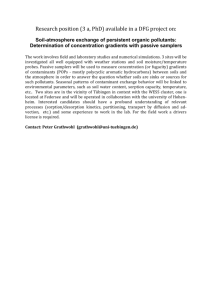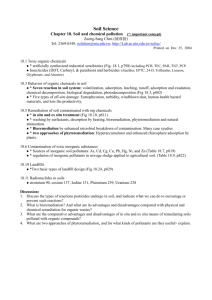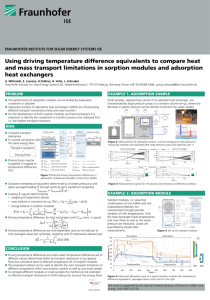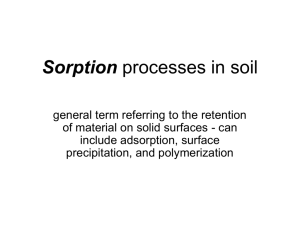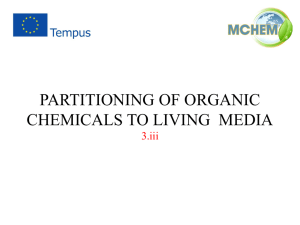3-ii Sorption involving inorganic matter
advertisement
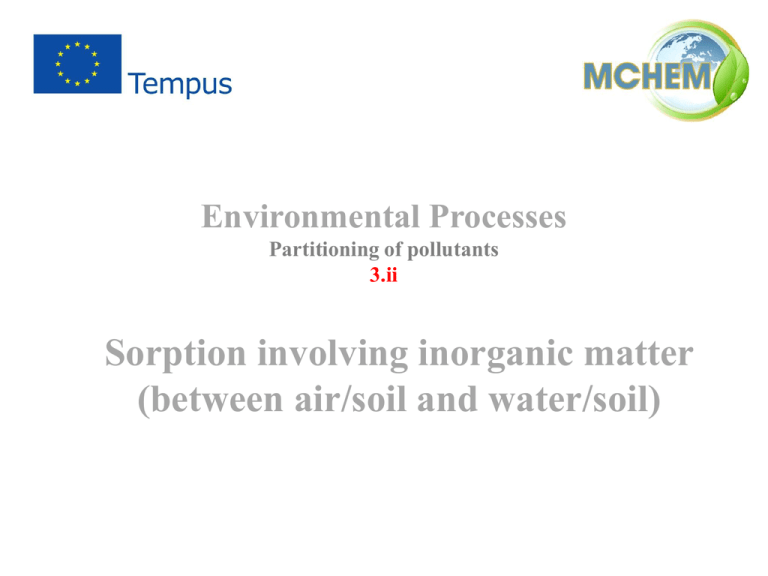
Environmental Processes Partitioning of pollutants 3.ii Sorption involving inorganic matter (between air/soil and water/soil) • Aims: – to provide overview of molecular interactions that govern phase transfer processes in the environment – to discuss partitioning behavior of a compound in the environment • Outcomes: – students will be able to evaluate compound partitioning between water and mineral matter of sediments – students will be able to estimate partition constants on the basis of solute's chemical structure and physico-chemical properties Environmental processing / Partitioning of pollutants / Sorption involving inorganic matter 2 Environmental processing / Partitioning of pollutants / Sorption involving inorganic matter 3 Adsorption of heavy metals on inorganic matter • Adsorption of heavy metal ions and complexes on clay minerals occurs as a result of ion exchange, surface complexation, hydrophobic interaction and electrostatic interaction • Organic components of clays and soils having carboxyl, phenol or amine groups may take part in heavy metal ion retention by complexation • Heavy metal ion adsorption by kaolinites and smectites results from pH-dependent inner-sphere surface coordination with the edge hydroxyl groups and outer-sphere ion exchange with the permanent negative surface sites Environmental processing / Partitioning of pollutants / Sorption involving inorganic matter 4 Sorption of neutral organic chemicals to polar mineral surfaces Environmental processing / Partitioning of pollutants / Sorption involving inorganic matter 5 Pesticides • • • Pesticides in river water are biodegraded by microorganisms, although some are adsorbed on suspended solids and accumulate in sediment Adsorption on soil is an important physicochemical characteristic governing the fate of pesticides in the environment Scientists attempted to predict soil sorption coefficients of organic pollutants from 1octanol/water partition coefficients. The soil sorption constant and soil organic matter were used as parameters in models to estimate the environmental mobility and fate of pesticides Environmental processing / Partitioning of pollutants / Sorption involving inorganic matter 6 • Clay minerals are commonly found in the soil environment, and smectites are the most important group for interacting with pesticides because of their high surface areas, moderate cation exchange capacities (CEC), and surface reactivities • Earlier studies have shown that smectite clays can adsorb many major types of pesticides, such as carbamates, ureas, nitrophenols, and triazines, to an appreciable extent Environmental processing / Partitioning of pollutants / Sorption involving inorganic matter 7 Adsorption Isotherms of pesticide on inorganic matter Environmental processing / Partitioning of pollutants / Sorption involving inorganic matter 8 Henry’s law constant The air - water partition coefficient is also referred as Henry’s law constant. It is easy to predict the air – water partition coefficient of environmental compounds at given temperature. The relationship between air and water is given as follows. K AW = ((VP/RT)/ (Swat)) Where: VP is vapor pressure of air R is ideal gas constant T is reference temperature Swat is molar solubility of water molecules KAW is air – water partition coefficient Environmental processing / Partitioning of pollutants / Sorption involving inorganic matter 9 Literature 1. Yuichi Fushiwaki, Kohei Urano, Adsorption of Pesticides and Their Biodegraded Products on Clay Minerals and Soils, Journal of Health Science, 47(4) 429–432 (2001) 2. M.M. Wahba and A.M. Zaghloul, Adsorption Characteristics of Some Heavy Metals by Some Soil Minerals, Journal of Applied Sciences Research, 3(6): 421-426, 2007 3. Schwarzenbach, R.P., Gschwend, P.M., Imboden, D.M. (2003). Environmental Organic Chemistry, 2nd Edition John Wiley and Sons, New Jersey 4. G. J. Lair, M. H. Gerzabek, G. Haberhauer, Environ Chem. Lett. (2007) 5:23–27, DOI 10.1007/s10311-006-0059-9 Environmental processing / Partitioning of pollutants / Sorption involving inorganic matter 10
